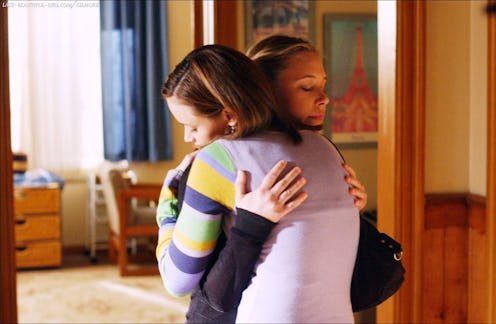Life
The Direction You Hug Someone Can Reveal A Lot About Your Emotional State

If you have ever questioned the authenticity of a hug, you may be on to something. A new study out of Ruhr University in Bochum, Germany explores the effect emotions have on the side in which someone hugs another person. According to Julian Packheiser, who spearheaded the study, researchers observed upwards of 3,000 hugs in an attempt to "...know if hug-related behavior is affected by the emotional context of the given situation," and to "...find out if motor characteristics such as handedness determine the lateralization of the embrace." In layman's terms the researchers wanted to see if your feelings, the situation you are in, and which hand you write with affect the way you hug.
First, the study looked at hugs that occurred in the arrival and departure gates of a German airport. The setting was chosen carefully as researchers believe hugs that take place in this context involve an array of different emotions. At the departure gate, it was surmised the huggers experienced negative emotions; not only because they were saying goodbye to their loved one(s), but because upwards of forty percent of those who fly experience, to some extent, aviophobia — a fear of air travel. Conversely, hugs that took place in the arrival gate produced positive emotions as the individual was reuniting with their loved one. Plus, they were experiencing the added relief of a completed flight.
Next, to study hugs that did not involve emotion, researchers looked at YouTube clips of actors who offered blindfolded hugs to strangers. Finally, researchers had study participants hug a mannequin after listening to either positive or negative affirmations to see with what side of their bodies the participants initiated the hug.
The study concluded people tend to preference right-sided hugs, but left-sided hugs are more frequent in both positive and negative social situations. Much of this can be linked to the basic construction of the brain. The organ is divided into two hemispheres by a band of fibers called the corpus callosum, and each controls the opposite side of the body. Since the right hemisphere of the brain generally controls emotion, it makes sense a hug would drift to the left when emotion is involved. In a neutral context, though, the hand one uses to write serves as a good predictor for what side on which they hug.
Another interesting fact the study revealed is that these findings do not necessarily apply to an embrace between two men. In this situation, left-sided hugs appear to be the preference. Sebastian Ocklenburg, another researcher with the hug study attributes this to, "...many men consider[ing] embraces between men to be something negative; therefore, they tend to perceive hugs as negative even in a neutral situation, such as saying hello."
A similar study exploring kissing was published last year in the science journal Nature. in this study, researchers set out to explore why humans tend to turn their heads right when kissing. this habit contradicts that provided in the hugging study as it depends less on neurological function, and more on a number of other factors cited in the study. Some of these include an inherent bias to turn one's head to the right—observable as early as during fetal development. Other hypotheses account for the pervasive influence of cultural norms, as well as the effect of one's right or left-handedness. The latter is particularly influential as only ten percent of people are said to be left-handed.
There's more to a hug than meets the eye, so next time you pull your love (or buddy!) in close, you may want to take a second to think about everything in your head that makes it possible.